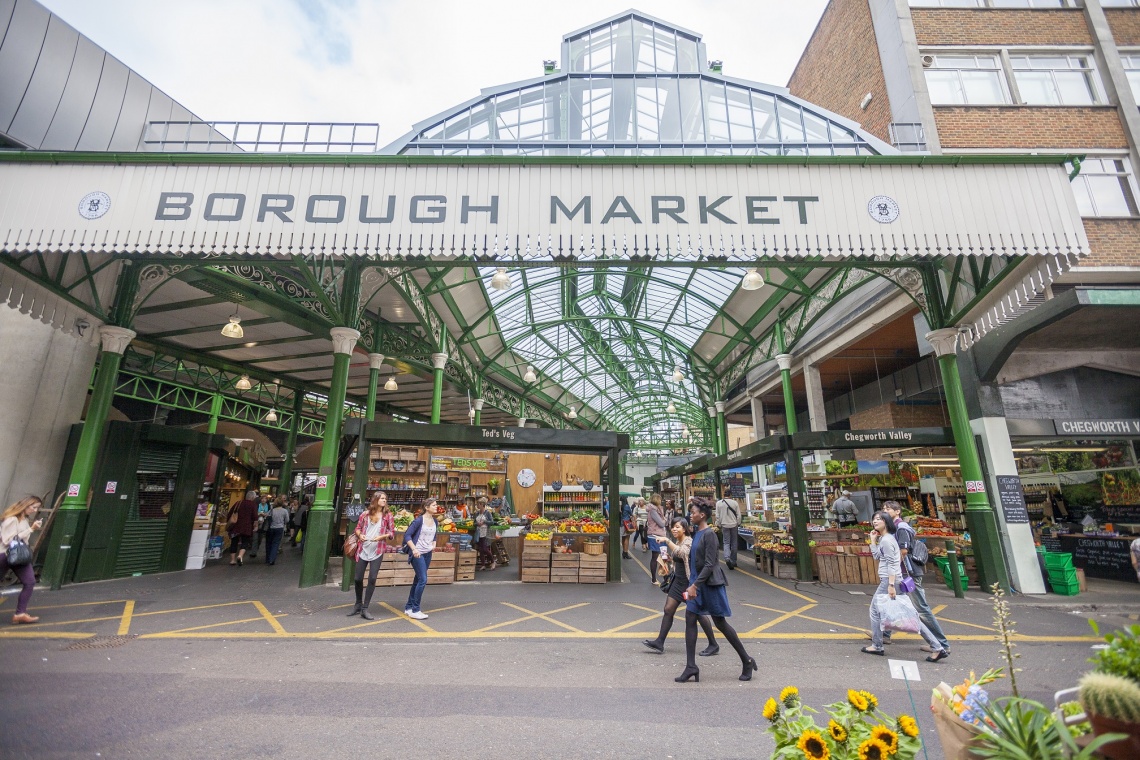Lying south of the Thames, in the north of Southwark, the Borough area of London is now one of the city’s most happening destinations. With global cuisine, a world famous food market, trendy cafes, bars and galleries, and cultural nerve centres along the river, you might not realise it’s also the city’s most historic borough. For those in the know, you can still unearth the stories of its past lives, down cobbled walkways, in ancient taverns and grand cathedrals, beneath the Victorian arches of its historic market and among the scattered remains of industry…
Due to its strategic position on the river, providing access to the city of London on the other side, Borough has always had its own unique influence. Its historic roles as a key travelling route, a vibrant trading hub and a bawdy district of entertainment have created the diverse, culturally rich area we know and love today. It was, in fact, already a destination as far back as the Roman times, home to a Romano-Celtic suburb with a bridge connecting to what was then Londinium.
Likely abandoned in the 5th century when the Romans left, Borough again became a thriving market town with the rise of the Saxons who called it South Work (hence the name Southwark today). It commanded a position as the centre of local government in Surrey and was an important defensive location for the city. Unfortunately these defences were overrun when William the Conqueror burned down the up-and-coming metropolis during his 1066 invasion.
The Middle Ages saw another boom period when Borough was yet again redeveloped with the construction of the first medieval bridge. By the 12th century, it had become an area of mixed reputation, with a church, a thriving produce market, but also a plethora of alehouses and brothels to keep travellers and merchants entertained on their way into the city. There were 23 coaching inns in total, including the galleried George Inn which is the only one remaining today. You can find it tucked off Borough High Street next to the Talbot Yard which once housed the Tabard Inn - both inns of such fame in their heydays that you’ll find them mentioned in the work of literary greats such as Chaucer, Shakespeare and Dickens.
By the 16th and 17th centuries, Southwark was a bustling thoroughfare, known for its theatres, inns, spas and resorts. The Puritan councillors of London frowned upon the theatre and so Borough, not officially part of the city, had become the home of playhouses - The Rose Theatre built in 1592 and the famous Globe Theatre in 1599, which you can still visit today. The area’s attention attracted less reputable forms of entertainment including bull and bear baiting and London’s original red light district along Bankside, with numerous prisons popping up alongside including the Clink, the King’s Bench and the Marshalsea. You can still visit the infamous Cross Bones Graveyard today, a burial ground for prostitutes, paupers and orphans who weren’t allowed burial within church land.
Industry was also taking hold with Bermondsey becoming the key hub of London’s leather manufacturing production and the river areas the centre of seafaring and ship building repair. However, due to overcrowding and poverty, Borough suffered several devastating outbreaks of the Plague and then the Great Fire of Southwark, with the death toll believed to be higher than the Great Fire of London itself.
By the 19th Century, Borough had re-established itself as an influential metropolis. Heavy development and industry attracted many people, resulting in ongoing issues with poverty and overcrowding. The area had always been a home to immigrants - the Flemish and Dutch in the 15-16th centuries, the German and Irish in the 18-19th and, in the 20th century, Africans, Afro-Caribbeans and Turkish Cypriots. In 1889 it became officially part of the County of London, Southwark Bridge was built in 1912 and the present London Bridge in 1972.
Borough Today
In recent years, Borough has shifted from a hub of industry to become one of London’s most cultural, diverse and innovative districts. It has undergone significant regeneration, welcoming the new while celebrating its strong roots and community spirit. It remains home to such historic attractions as Borough Market, Southwark Cathedral, the Old Operating Theatre Museum, the Clink Prison Museum, Shakespeare’s Globe and HMS Belfast, as well as new landmarks including the Tate Modern and The Shard.
See our guide to Art and Culture in SE1 for more of the area’s cultural highlights.
Borough Market
Borough Market is one of the oldest establishments in the area, estimated to be at least 1,000 years old. After the building of the Medieval Bridge into London, farmers, bakers, brewers and fishermen gathered along Borough High Street, serving the flow of travellers into the city. This early bazaar proved such competition to London’s official crown-owned markets that a 1270 document shows citizens were banned from crossing over to Southwark to buy “corn, cattle, or other merchandise”.
However, by 1550 all was smoothed over when Edward VI sold control of Southwark to the City for £1,000. The market flourished but it would have been a very different affair to the one we know today with animals brought alive to be slaughtered and the brutal realities of life during this time on show - an engraving from 1616 shows the busy market in action beneath the gateway to London Bridge atop which the severed heads of traitors are skewered on spikes!
In 1754 the market was causing such congestion it was abolished by an Act of Parliament. Just as industrious and determined as the residents of Southwark today, the locals fought back and won permission to set up a new market in 1756 within Rochester Yard, where it still stands today. By the 19th century it was firmly established as a crucial hub for the city’s fruit and vegetable wholesale trade which continued into the 20th century.
However, by 1970, with the growth of supermarkets and the building of New Covent Garden market, the market began to deteriorate. It looked set to be consigned to a page in the history books until the rise of the artisan food movement in the 1990s, when a handful of pioneering businesses moved into the area’s abandoned warehouses. In 1998, Neal’s Yard Dairy, Brindisa and Turnips, still market favourites today, began public warehouse sales. From there, a three-day Food Lovers’ Fair was held bringing together 50 of Britain’s finest food producers. It was such a success that a regular monthly market was instigated which quickly led to a weekly event, and, before you can say artisanal sourdough, the market we know today was born - as bustling and vibrant as when it first began.
Southwark Cathedral
Tucked next to the market, Southwark Cathedral might now lie in the shadow of the Shard, but its turbulent history stretches much further back. In the 7th Century there was said to be a small community of nuns on the site, up until the 1066 arrival of the Normans, when Norman Knights established a priory there. The priory’s church was dedicated to St Mary and became known as St Mary’s Overie (‘over the river’). A hospital was also built alongside in 1173 named after St Thomas Becket - the ancient predecessor of St Thomas’s Hospital today.
After being damaged in the Great Fire of Southwark in 1212, the priory was rebuilt in the new pointed style, beginning to resemble the building standing today and becoming London’s first Gothic Church. However, with Henry VIII’s Dissolution of the Monasteries in 1539, the priory was dissolved. Fortunately its wily congregation struck a deal and began renting the church off the crown, renaming it St Saviour’s. Eventually the church was bought off King James I in 1611 for £800 by a group of merchants within the congregation known as ‘the Bargainers’.
During this time, as Southwark thrived as an entertainment district, the church became a draw for those involved in the theatre, including Edmund Shakespeare (Shakespeare’s brother) who was buried there in 1607. Shakespeare himself was believed to have been present in the congregation when John Harvard was baptised.
In 1820 the church, desperately in need of further repairs, was at risk of being flattened to make way for a new viaduct from London Bridge station. Fortunately, after much argument, the building was restored (the viaduct standing just 18m away to this day), renovated under the direction of Sir Arthur Blomfield who designed the Royal College of Music in Kensington.
In 1905 the parish church officially became Southwark Cathedral. Today it remains a functioning Cathedral, but visitors are welcome to come and admire the stunning interiors, its blend of medieval, Norman and Gothic elements testament to its long history and will to survive.





